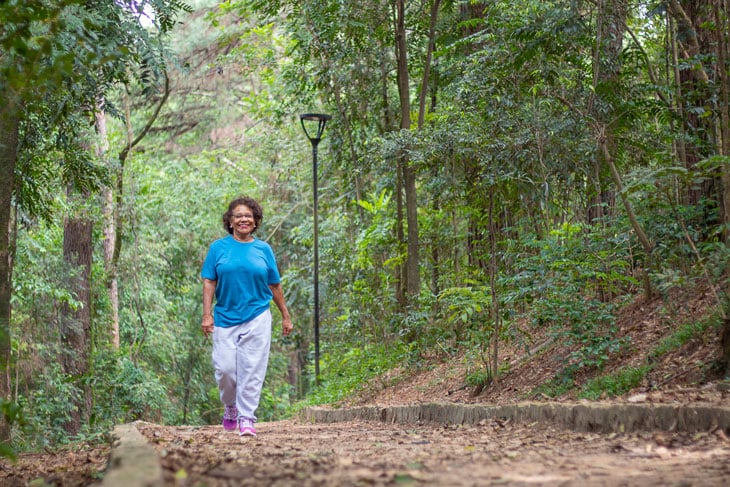Thrive Wellness: Consider Taking a Stroll
Updated from the original publication on March 25, 2021.
Spring is officially here….and with this wonderful season comes longer days and a trend towards warmer days as well. Fresh air and vitamin D are just a few of the health benefits derived from walking outside. Consider going for a stroll around your neighborhood and community – get outside and really breathe in the fresh air.
As a cardio-vascular activity, walking is good exercise for, and beneficial to, your heart and lungs as well as your entire respiratory system. It is important for our bodies to effectively and efficiently process oxygen to enhance our everyday lives – and walking is wonderful because it is easier on the joints and muscles than jogging and running.
Walk with a friend, with your family, with a pet, in a walking group – however you choose to engage in this easy, fun activity – your body will thank you. At first, you may be a little sore afterward, but as long as you don't push yourself too hard, your body will respond as you become stronger.
Set small, achievable, reasonable goals and aim for one or two days a week to start – working up to three or four days a week eventually. 15-20 minutes should do the trick, and walk briskly but at a pace that you would still be able to carry on a conversation if walking with another person.
This pace helps to ensure that you are not exceeding a moderate-to-somewhat hard level of exertion. If you begin to get out of breath, slow down your speed. As time goes on and your body adjusts, you will be able to walk longer and further.
Don't be discouraged, and try to be patient with yourself. After all, you are taking "steps" in the right direction for your health, so KUDOS to you!
Due to inclement weather, if you cannot get outside to walk on your selected day – consider walking inside or under covered walkways. You may even have access to a fitness center with treadmills, and if so, you will have that option. When you are finished, do some light stretching for five to 10 minutes and pat yourself on the back!

Check out this information on walking from the International Council on Active Aging's Walking Center.
How to ensure you are walking correctly.
Here is a quick and easy way to check the quality of your walking pattern. All you need is a full-length mirror!
Walk directly toward the mirror and observe the following:
- Your knees are pointing forward.
- Your hips are level.
- Your arms swing rhythmically as you walk.
- Both sides of your body are symmetrical (arm swing, step length, etc.).
- You are walking tall (e.g. your head is erect and your ears are directly above your shoulders).
Walk alongside a wall mirror (a full-length mirror is helpful for this activity) and observe the following:
- Your heel makes contact with the floor first on each step.
- You can feel the pressure roll up to the toes as you push off from the floor.
- Your knee is almost fully extended before your heel contacts the floor.
- Your steps are of equal length.
- Your ears are directly above your shoulders and your body is upright.
The following walking step statistics are also shared from the "Walking for Health" part of the ICAA Walking Center.
These provide typical and common walking ranges that most people are interested in knowing. If you are interested in tracking your steps, you can use a pedometer or the features on your smartphone device and/or watch.
Walking Center Step Statistics:
- 2.5 feet: average person's stride length
- 2,100 average steps: about one mile
- 10,000 steps: about 5 miles
- 10,000 steps: expends about 300 to 400 calories (depending on body size and walking speed)
- 1,200 steps: 10 minutes of walking
- 3,100 - 4,000 steps: 30 minutes of moderately intense walking
Note: all these equivalents are averages that will vary among individuals
How many steps for an active lifestyle?
- sedentary: <5,000 steps/day
- low active: 5,000-7,499 steps/day
- somewhat active: 7,500-9,999 steps/day
- active: >or=10,000 steps/day
- highly active: >12,500 steps/da
However, you choose to engage in walking this spring, set reasonable goals and be proud of yourself! Set the example, and maybe others will want to join you. Some PSL communities have well-attended walking groups.
Enjoy the opportunity to breathe freely and deeply. In our everyday lives, we often take short, rushed, intermittent breaths – regular breathing is so much more therapeutic when done with more purpose and thought.
Experience all the fun and rejuvenation that walking will bring to your body as well as other related health benefits along the six dimensions of Thrive Wellness: Emotional, Social, Spiritual, Physical, Intellectual, and Vocational.
Please stay tuned for next month’s post for Thrive Wellness updates and share this information with your friends. Invite them to subscribe to the PSL blog. Thrive Wellness monthly blogs will post at the end of each month.
People who come to Presbyterian Senior Living come for more than just a place to live– they come to feel energized, challenged, and fulfilled; they come to THRIVE.
About Presbyterian Senior Living
As the trusted leader in aging services, Presbyterian Senior Living combines over 97 years of experience with innovative approaches to senior communities and services. Across our 27 communities in PA, MD, OH, and DE, we serve over 6,000 seniors. We are committed to: FOSTERING teamwork and responsibility. UPHOLDING integrity in every action. EMBRACING innovation to create opportunities for everyone’s success. LEADING with compassion and respect.


